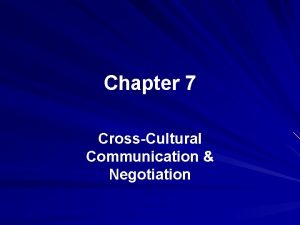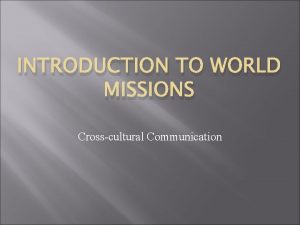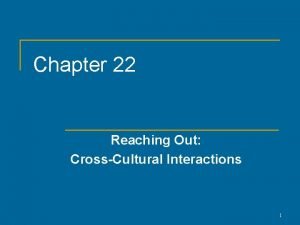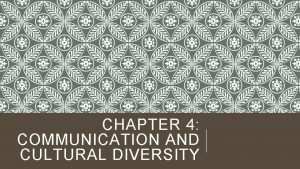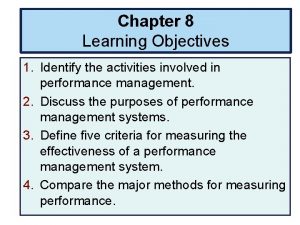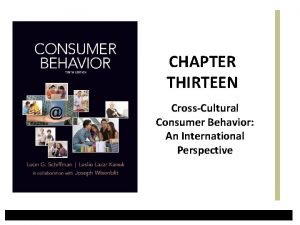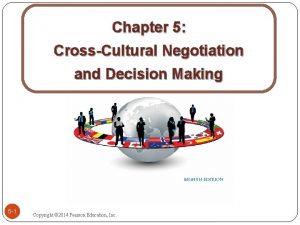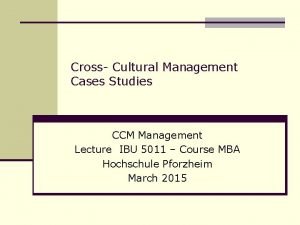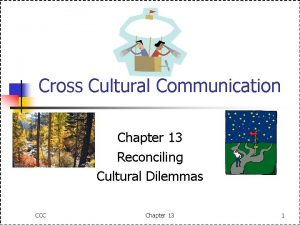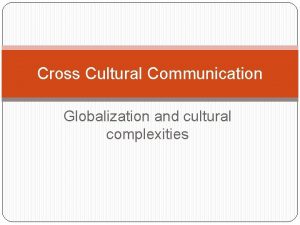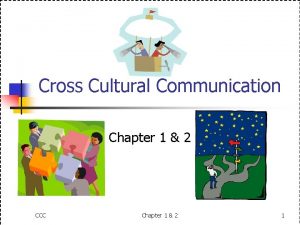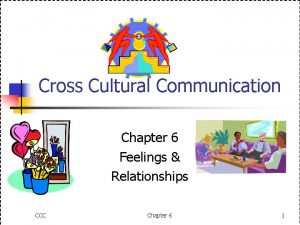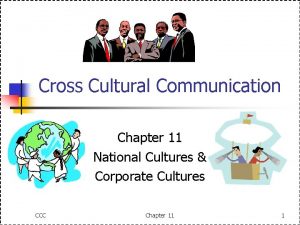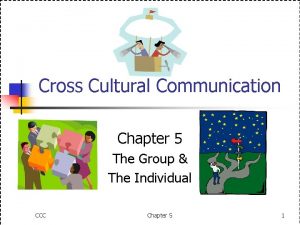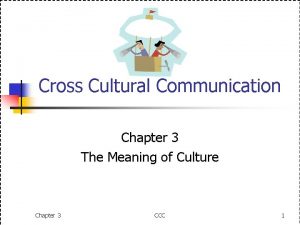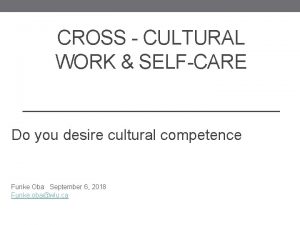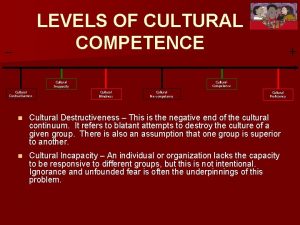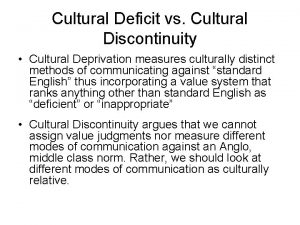Cross Cultural Communication Chapter 9 How We Manage
























- Slides: 24

Cross Cultural Communication Chapter 9 How We Manage Time CCC Chapter 9 1

Learning Outcomes n n CCC How we manage time Shared expectations about time Sequential Vs Synchronic Relative importance cultures give to Past, Present, and Future Chapter 9 2

The Concept of Time n n Primitive societies see the time in the context of ‘before’ or ‘after’ moons, seasons, sunrises and sunsets. For educated societies, two contrasting notions: n n CCC Time as a line of discreet events : minutes, hours, days, months, years, each passing in a never ending succession. Time as a circle : revolving so that the minutes of the hour repeat, as do the hours of the day, the days of the week and so on. Chapter 9 3

The Concept of Time n Time is viewed as a factor that organizations must manage n n n Time is considered universally in the categories of past, present and future but not equal importance is given to each of these. Conception of time is strongly influenced by culture n n CCC Time and motion studies Just-in-time Time-to-market Product life cycle (PLC) Time is interwoven with how we plan, strategize and coordinate our activities with others It is an important dimension how we organize experience and activities Chapter 9 4

The Concept of Time n CCC Kluckhohn and Strodtbeck identified three types of culture : n Present-oriented : relatively timeless, tradition-less and ignores the future n Past-oriented : mainly concerned to maintain and restore traditions in the present n Future-oriented : envisaging a more desirable future and setting out to realize it. Chapter 9 5

The Concept of Time n n n Time has meaning not only to individuals but to whole groups or cultures. “Time is a social construct enabling members of a culture to coordinate their activities” Emile Durkheim, French Sociologist This has an important implications in a business context: n n n CCC Time agreed for a meeting may be approximate or precise. There may be an expectation of mutual accommodation as to the exact time of delivery of product or there may be a penalty clause imposed by one party on another Organizations may look ahead a long way, or get obsessed by the monthly reporting period. Chapter 9 6

Sequential Vs Synchronic Cultures Sequential n n n CCC Line of sequential events passing at regular intervals Time is considered as a dotted line with regular spacings Events are organized by the number of intervals before or after their occurrence “Critical path” is worked out in advance with times for the completion of each stage. People hate to be thrown off the schedule because of unanticipated events. Chapter 9 Synchronic n n People track several activities in parallel : Multi-taskers Put emphasis on the number of activities run in parallel There is final, established goal but there are numerous and possibly interchangeable stepping stones to reach it. A person can “skip between stones”on the way to final target. 7

Sequential Vs Synchronic Cultures Synchronic Sequential n n n CCC Sequential people tend to schedule very tightly, within divisions between time slots. Major influence on the conduct of business in N-W Europe and North America “Straight lines” may not be always the best way of doing something. It is blind to the effectiveness of shared activities and cross-connections. Chapter 9 n n n Passage of time important but several others cultural values vie with punctuality Necessary to “give time” to important or higher status people. Meeting times may be approximate : most of the people involved may be involved in parallel activities, any waiting involved may not be problematic. 8

Sequential Vs Synchronic Cultures Sequential n n n Synchronic People do only one thing at a time Everything has its time and place for sequential thinker Any change in this sequence make the sequential person uncertain n n CCC Chapter 9 Synchronic / polychronic cultures less insistent upon punctuality Passage of time important but several others cultural values vie with punctuality Necessary to “give time” to important people to show value to relationships. Meeting time may be approximate 9

Sequential Vs Synchronic Cultures Synchronic Sequential n Effort towards going from A to B in a straight line with a minimal effort and maximum effect ( efficiency) n n n People who do only one thing at a time may unknowingly insult those who are used to doing several things. n n CCC In sequential / punctual cultures, exactly the right quantity of food will be prepared, may get spoiled or cold if guests not in time. n Chapter 9 Effort towards developing closer relationships ( long-term) People who do more than one thing at a time may unknowingly insult those who are used to do only one thing Lot of adjustments in terms of time, receiving guests, cooking more food, etc. More than enough food in case more guests drop in unexpectedly. 10

Measuring Cultural Differences in relation to time n n CCC Methodology to measure approaches to time provided by Tom Cottle “Circle Test” Think of the past, present and future as being in the shape of circles. Please draw three circles on the sp[ace available, representing past, present and future. Arrange these circles in any way you want that best shows how you feel about the relationship of the past, present and future. You may use different size circles. When you have finished, label each circle to show which one is the past, which one the present and which one the future. Chapter 9 11

Measuring Cultural Differences in relation to time Findings shown in Fig. 9. 1: four possible configurations 1. Absence of zone relatedness : typical Russian approach to time , no connection between past, present and future, though in Russian view, future is much more important than present and more important than the past 2. Temporal integration : French and Malaysians : all three overlap considerably 3. Partial overlap of zones 4. Touching but not overlapping : hence not “sharing” regions of time between them. n n CCC Characteristics of Belgians & British : small overlap British : strong overlap with the past Chapter 9 12

Time Horizon n CCC With reference to sharing short-term and long -term horizon, Cottles Test with Duration Inventory Technique, key findings suggested that : Longest horizon found in Hong Kong and shortest in Philippines ( see Fig. 9. 2) Japanese long term vision is in sharp contrast with “quarterly” thinking of Americans. Chapter 9 13

Time orientations and management n n Business organizations are structured in accordance with how they conceive of time. American view of the future that the individual can direct it by personal achievement and inner-directed effort. n n n In French Culture , the past looms far larger and is used as context in which to understand present. n CCC Individual achiever can not do very much about distant future, too many events can occur – USA’s idea of future is short term, controllable from present. “going for quick buck” & great importance to quarterly figures Past, present and future overlap synchronically so that the past informs the present and both informs the future. Chapter 9 14

Time orientations and management Human relations and orientations to time n n n Any lasting relationship combines past, present and future with ties of affection and memory Synchronic cultures are more “we”oriented ( collectivistic) and usually more particularist in valuing people known to be special. Sequential cultures tend to see relationships as more instrumental n n CCC Higher pay is the means towards still higher performance and customer’s purchase is a means to receive higher bonus. Durable, synchronic relationships in which the past, present and future of the partners are bound together in co-evolution may be becoming more effective way to manage. Chapter 9 15

Time orientation and management Time orientation and authority n n In nations in which past looms large and where time orientations overlap, status is more likely to be legitimized by ascription based on durable characteristics such as age, class, gender, ethnicity and professional qualifications. In sequential culture countries the future is a sequence of episodes of relative successes and failures n n CCC People unburden themselves of relationships and dependencies not useful in the next stage of their career. Authority of individual depends upon the latest achievement; those on the up today may be gone tomorrow. Chapter 9 16

Time orientation and management Policies of Promotion and assessment n n n Sequential and synchronic cultures, and those concerned with the past or the future, may also assess and promote differently. In sequential cultures, the more that employee can be held responsible for a rise or fall in fortune the better, and the supervisor tempt to minimize their own roles, or that of the relationship with the employee, since it does not help the employee to see his or her own recent achievement separated out as an increment of gain or loss. In more synchronic organizations employee may be favorably assessed and promoted for the positive relationship established with the supervisors, who see that the relationship developing over time and accumulating knowledge and mutuality n CCC Supervisors acknowledge their role in making the subordinate’s career. Chapter 9 17

Time orientation and management Managing change in a past-oriented culture n Synchronic cultures carry their pasts through the present into the future and will refuse to consider changing unless convinced that their heritage is safe. n n n CCC All change must include continuity, that is, staying the same in some respects so as to preserve identity. Tight sequential agenda might backfire in synchronic cultures In synchronic cultures, important thing is what they get to the end, not the particular path or sequence by which that end is reached. Chapter 9 18

Time orientation and management Planned sequences or planned convergence? n n Planning varies significantly between sequential and synchronic cultures In sequential planning : n n n CCC It is vital to get all the means or stages right and completed on time. Planning consists largely of forecasts, that is, extending existing trend lines into the future and seeing this as “more of the same” Strategies consist of choosing desirable goals and then discovering the most logical and efficient means of attaining them Present and future are causally linked so that rewards produce greater achievements, which produce greater rewards When environment changes, everything to be recalculated from the start. Deadlines important : they signal the end of one link in causal chain and the beginning of the next and keep the things “on schedule” Chapter 9 19

Time orientation and management Planned sequences or planned convergence? n In synchronic planning : n n n There is growing evidence that sequential planning processes work less well in turbulent environments n n n CCC The goals are what is most important More paths one can devise to their realization, the better the organization fares against unforeseen events that block one path or another They are too brittle, too easily upset by unforeseen events Tend to concentrate on the near future testifies to the vulnerability of long sequences Synchronic plans tend to converge or “home in “upon predetermined targets, taking into consideration fusions and lateral connections between trends that sequential planning often overlooks. Chapter 9 20

Time orientation and management Planned sequences or planned convergence? n Scenario Planning : combination of sequential and synchronic styles of planning n n CCC Scenarios for many alternative futures are presented as if writer was a contemporary commentator explaining how business had reached that point Past, present and future are synchronized within the imagination, and these developments are traced from the past through the present into diverging futures and are written up as stories or narratives Re-establish forecasts within the scenarios, so that each “synchronic scene” has a different sequence of events. Both sequencing and synchronizing work together. Chapter 9 21

Reconciling the Sequential and the Synchronic : Exercise – I n 1. 2. 3. 4. Some managers are arguing about the best ways of improving cycle time and getting products to market when they are needed. There were four possible views : It is crucial to speed up operations and shorten time to market. Time is money. Enemies of tighter schedules and faster deliveries are too much talking and relating to each other. It is crucial to speed up operations and shorten time to market. The faster jobs are done the sooner you can “pass the baton” to colleagues/ customers in the relay race. Just-in –time synchronization of processes and with customers is the key to shorter cycle times. The more processes overlap and run simultaneously the more time saved. Just-in-time synchronization of processes and with customers is the key to shorter cycle times. Doing things faster results in exhaustion and rushed work. Indicate with “ 1” the approach you believe would be favored by your closest colleague at work, and with “ 2” the approach which you believe would be their second choice. CCC Chapter 9 22

Exercise I : Findings n Answer 1 & 4 show approval of respectively high speed sequences and just-in-time synchronicity, but reject the opposite orientation. n Answer 2 approves of high-speed sequences and connect it to synchronic processes n Answer 3 approves of just-in-time synchronicity connected to high speed sequences CCC Chapter 9 23

Practical tips for doing the business in past-, present- and future-oriented cultures n n CCC Table 1 / Pg. 138 highlight the differences between past-, present- and future-oriented cultures Table 2 / Pg. 139 shows tips for doing business in past-, present - and future-oriented cultures Table 3 / Pg. 139 recognizes time orientation in sequential and synchronic cultures Table 4 / Pg. 140 shows when managing and being managed in sequential and synchronic cultures Chapter 9 24
 Cross cultural communication
Cross cultural communication Cross cultural communication and negotiation
Cross cultural communication and negotiation Cross cultural communication in business negotiations
Cross cultural communication in business negotiations Examples of cross cultural communication
Examples of cross cultural communication Chapter 22 reaching out cross-cultural interactions
Chapter 22 reaching out cross-cultural interactions Chapter 22 reaching out cross-cultural interactions
Chapter 22 reaching out cross-cultural interactions Chapter 22 reaching out cross-cultural interactions
Chapter 22 reaching out cross-cultural interactions Chapter 4 communication and cultural diversity
Chapter 4 communication and cultural diversity Chapter 4 communication and cultural diversity
Chapter 4 communication and cultural diversity Chapter 8 learning to manage
Chapter 8 learning to manage Cross cultural adaptability inventory ccai
Cross cultural adaptability inventory ccai Conclusion of consumer behaviour
Conclusion of consumer behaviour Cross cultural differences and similarities
Cross cultural differences and similarities Jean koh peters
Jean koh peters Cross cultural consumer behavior
Cross cultural consumer behavior Cross cultural negotiation and decision making
Cross cultural negotiation and decision making Kim young yun
Kim young yun Importance of cross cultural leadership
Importance of cross cultural leadership Cross-cultural preparation
Cross-cultural preparation Terry cross cultural competence
Terry cross cultural competence Short case study on cross cultural management
Short case study on cross cultural management Test cross and back cross
Test cross and back cross Test cross and back cross with example
Test cross and back cross with example What is incomplete dominance
What is incomplete dominance Difference between monohybrid and dihybrid crosses
Difference between monohybrid and dihybrid crosses


